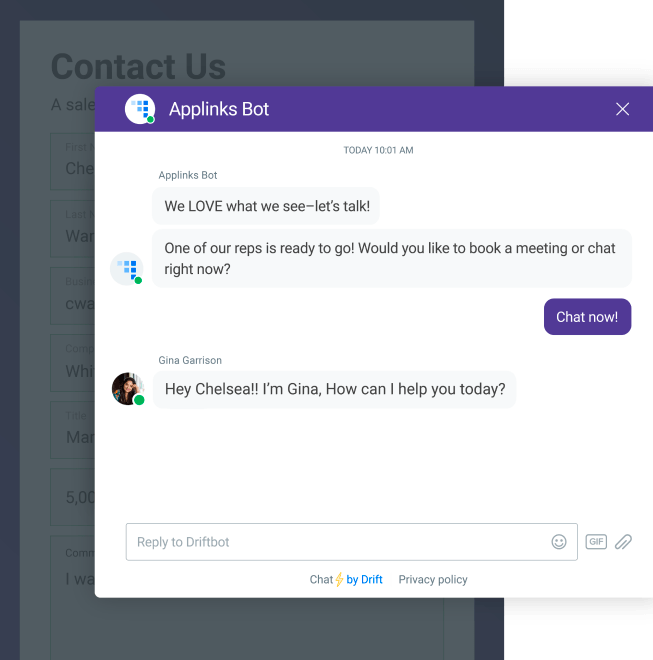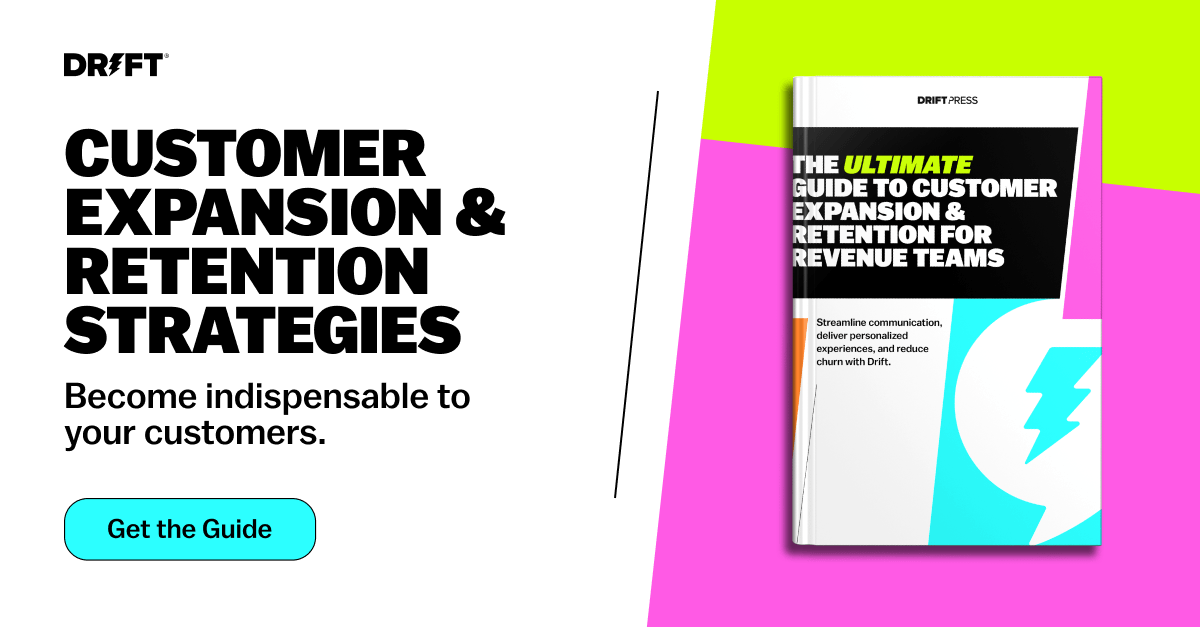Pipeline, pipeline, pipeline 🎵
Like a refrain in a trending song, we’ve all been hearing “pipeline” on repeat — whether it’s in team meetings, company-wide emails, or even on LinkedIn. And that’s to no one’s surprise: A report by Ebsta and Pavilion found that pipeline generation dropped by 42% in 2022, and has yet to recover.
For this reason, today’s go-to-market (GTM) teams are having to critically examine and revise how they drive revenue to future-proof their businesses. But, with customer expectations growing, new tools flooding the market every day, and a greater emphasis on doing more with less, building a reliable digital pipeline can be challenging.
That is, unless you adopt a conversational strategy that engages site visitors in real time while also providing buyer insights to better inform your GTM strategy.
To show you how it’s done, I spoke with three of Drift’s top customers who have wholeheartedly adopted the conversational approach. Because, as the owner of Drift on Drift, I love hearing how other organizations are using conversations to drive more pipeline, faster. Our super users include:
- Kerry Rana, Senior Director of Digital Marketing and Experience, ExtraHop
- Kimberley Ong, Senior Director of Marketing Operations, eSentire
- Lindsay Hasz, Director of Digital Insights and Optimization, SAP Concur
Below are their best practices for leveraging Drift to turn your pipeline numbers around. Keep reading to learn the three steps you need to follow to ensure that, the next time you hear “pipeline,” it will be music to your ears 👇
This panel was originally part of our Conversations (Re)mastered event. If you want to watch the full recording, click here. Otherwise, keep reading for all the insights 💡
Streamline Your Buyer’s Website Journey
Whether it’s someone who just heard about your brand, a buyer researching your solution, or a customer looking for support, your website is the first place that people go to get answers about your business. And each of those people expect to get those answers quickly and easily.
In fact, according to a report by Avionos, 85% of B2B buyers would switch to a competitor if a supplier’s digital channel couldn’t keep up with their expectations. This means your website must be able to cater to each site visitor and their needs — otherwise you risk losing out on pipeline.
For our super users, Drift’s chatbots are the key to delivering the right user journeys to the right visitors. Because, by varying your bot flows (i.e. playbooks) across your web pages and audiences, you can automatically serve up an experience that best suits that visitor.
For example, when Lindsay’s team at SAP Concur first implemented Drift, they started out with four different types of playbooks — engage all, return visitor, skip the form, and customer — to broadly segment their website traffic. By dividing their traffic in this way, they were able to cater to different visitor needs and interests. And, as Lindsay explains, that was just the beginning:
“We gave [our] 10 markets those four playbooks to get started. That was a really good way for everybody to feel like we’re invested in the journey. And then, from there, we sort of expanded into industries, products, and then company size.”
While a strategic playbook will help speed up the process of engaging and nurturing site visitors, Kimberley and Kerry’s teams have found that Drift Fastlane drives quick conversion wins. With Fastlane, when a visitor fills out a form to say they want to chat with sales, you can qualify them in real time using data from your tech stack and then instantly engage them in a conversation. As a result, you can easily jump-start the sales process with people you know you want to convert.

Personalize the Target Account Experience
While streamlining the website experience for all your site visitors is a good first step to boosting your pipeline, if you really want to move the needle for your business, you need to engage your most sought-after accounts. And that means rolling out the red carpet for them.
To do this, you need robust data — and, as all three of our super users attest, that is where Drift’s integrations truly shine. With integrations, you can easily access the most up-to-date information on your target accounts, whether that’s basic information like contact name and industry or more in-depth data like account activity and buying stage. As Kerry explains:
“Drift is able to help pull a company name, we’re able to figure out what industry [the site visitor is] in, and we utilize 6sense and Salesforce data to really get that accuracy. … That data allows us to figure out what we need to do to ensure that we are giving a personalized experience.”
Using this information, you can then deliver a top-tier experience that’s tailored to specific target accounts. For example, you can automatically notify the dedicated rep when their target account is on your website, so they can jump into a live chat.
Beyond one-to-one personalization, you can also set up playbooks that provide personalized experiences for target segments. For example, Kimberley’s team at eSentire has a playbook that surfaces content specific to the legal industry — one of their many target sectors.
No matter which type of target account playbook you’re creating though, remember to check in with your sales team before hitting publish. Because, through their conversations with buyers and customers, your sales team has gained valuable insight into the accounts that are the best fit for your brand, any frequently asked questions, as well as the resources that drive the most value. By communicating about your target account strategy upfront, you ensure that both you and your accounts get the most out of your playbooks.
Focus on Driving Value for Your Customers
Unlike buyers in the middle of the sales process, your existing customers turn to your website to resolve issues quickly. Zendesk even found that 70% of customers expect a company to have a self-service portal or readily-available content for precisely this reason.
This means, if your website doesn’t provide the fast, always-on service that customers expect, there’s a good chance they will jump ship — and, as a result, you will bleed expansion pipeline. So, how do you build a website experience that meets your customers’ standards?
According to our super users, this can actually be as simple as collaborating with your customer teams to craft a playbook that is dedicated to your customers and their most common requests. For example, you can set up a chatbot to answer common support questions (e.g. “I can’t log in”) or guide them to specific resources like a customer training.
Not only does this reduce the time it takes for customers to resolve issues, but it also deflects simple questions away from your team, so they can focus on expanding customer use cases and driving more revenue for the business. As Kimberley sums up:
“Being able to create a distinctive playbook just for customers and a playbook just for the sales development reps (SDRs) helps reduce the noise and helps everyone stay on track in terms of the audiences that they should be reaching out to.”
In addition to providing instantaneous support, you can leverage customer-specific playbooks to help customers see more value from your solution. By integrating your CRM with Drift, you can pinpoint exactly which customer is chatting in, their current product usage, and set the bot to automatically serve up trainings and guides in accordance to that package.
With these insights, you can also customize your bot’s calls-to-action to pique the customer’s interest in products that work well with what they already have, opening the door for expansion. At SAP Concur, for example, if Lindsay’s team knows that a customer owns their expense product, they will have their chatbot recommend expense add-ons or talk about how their expense product pairs well with their travel product. This makes your cross-sell and upsell efforts feel a lot more personal and a lot less forced, which serves to increase your expansion pipeline.
Final Thought
Although the rise of digital interactions has transformed the way that we sell, that doesn’t mean that it’s ended conversations with your buyers and customers altogether. Instead, it means that you can now have even more and even better conversations.
Because, whether it’s on your website or off of it, conversations are the best way to engage and convert new buyers, as well as support your existing customers. And the more effective you are at doing that, the more pipeline and revenue you will drive for your business.
So, as you build out your Drift instance, always keep your buyers and customers at the top of your mind. Because that is how you will be able to ensure your site visitors are getting the best experience possible — which will ultimately lead to more pipeline.








